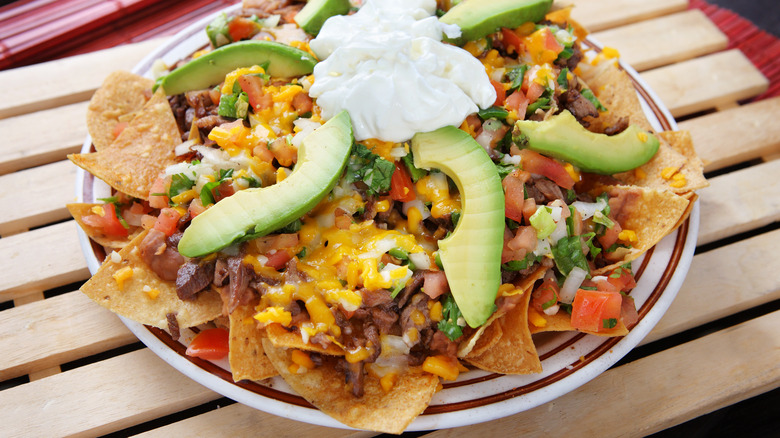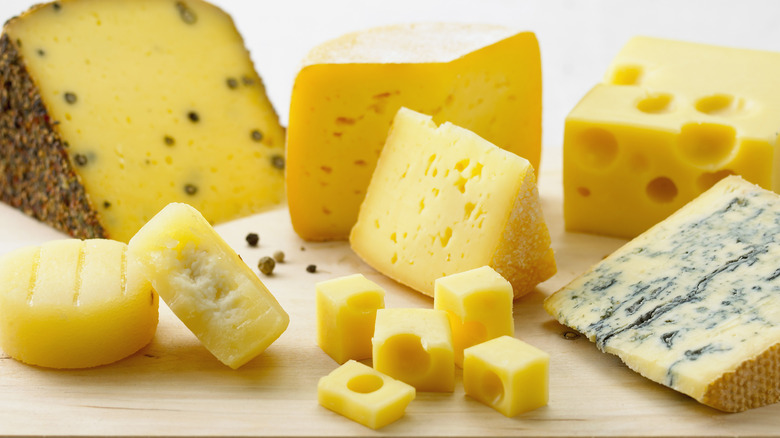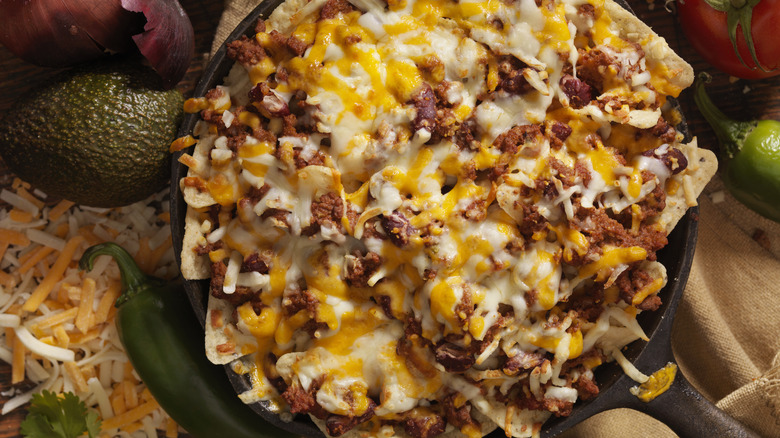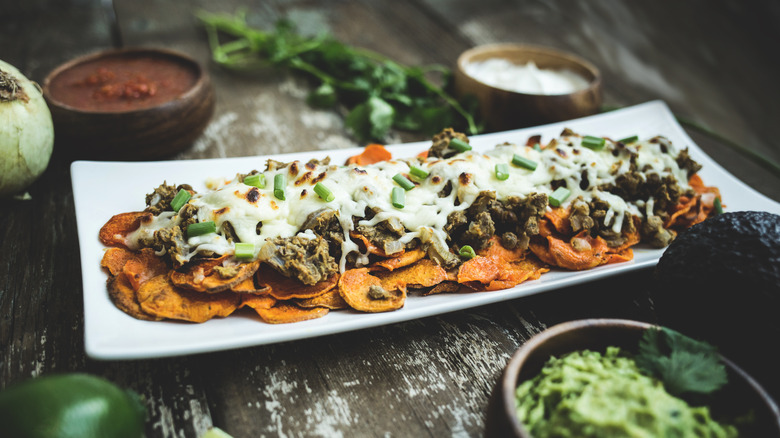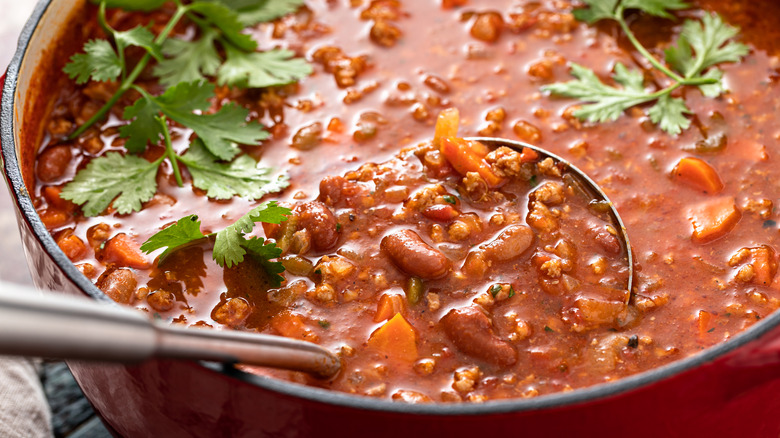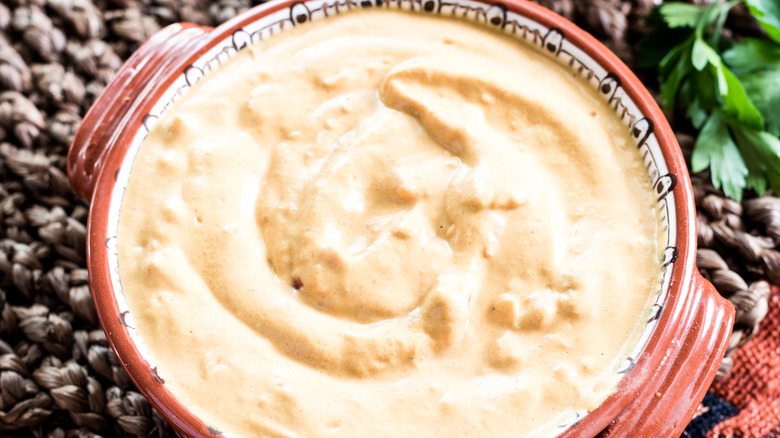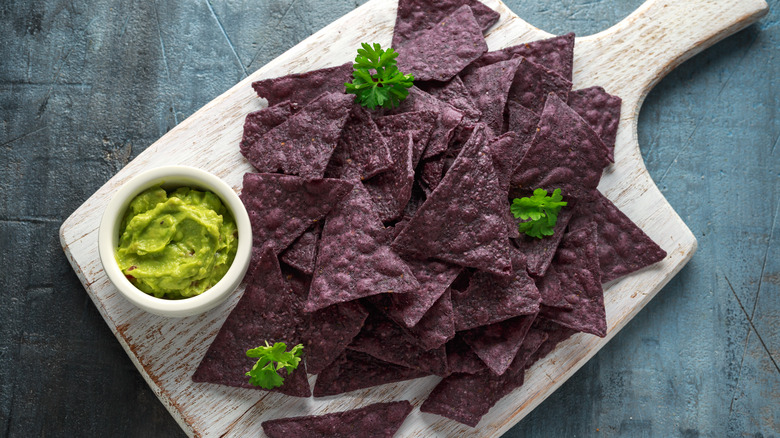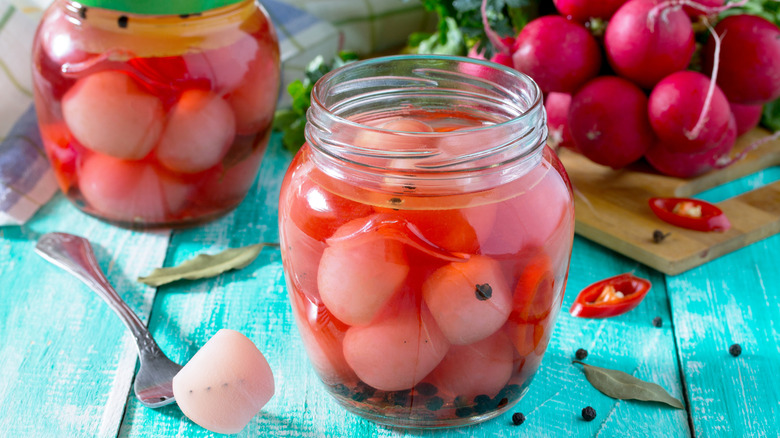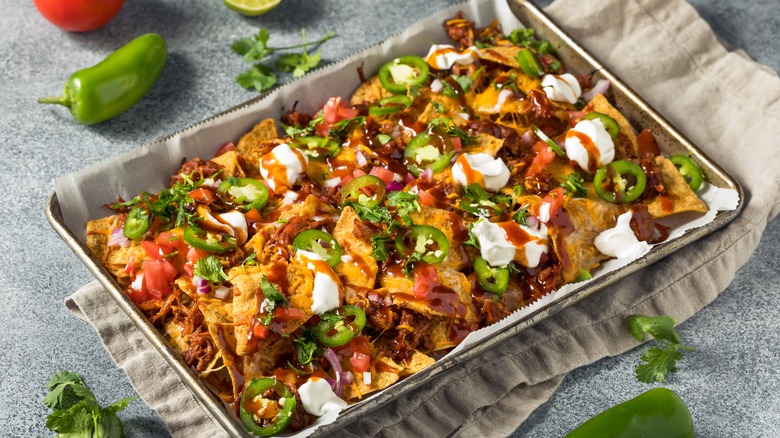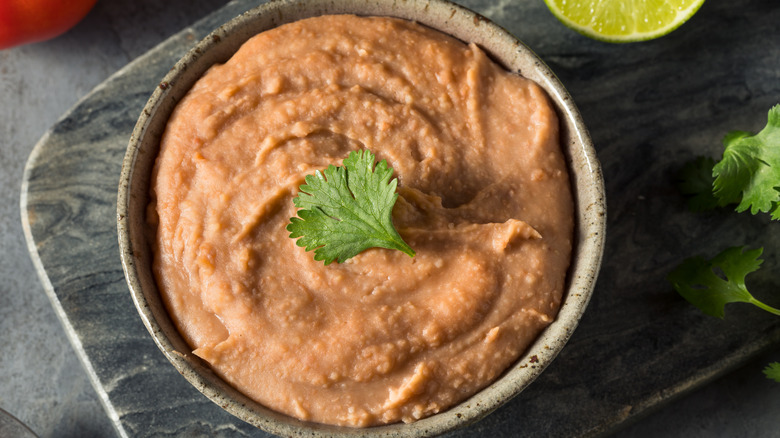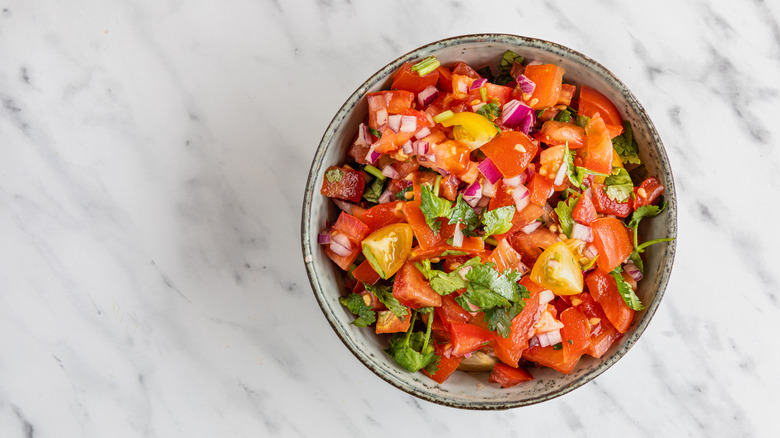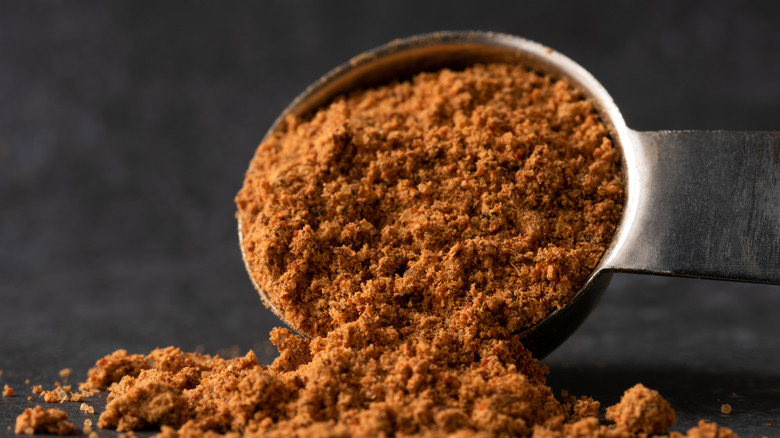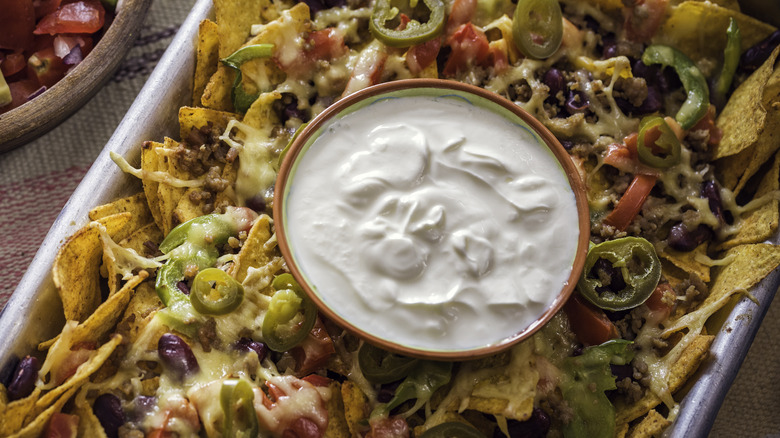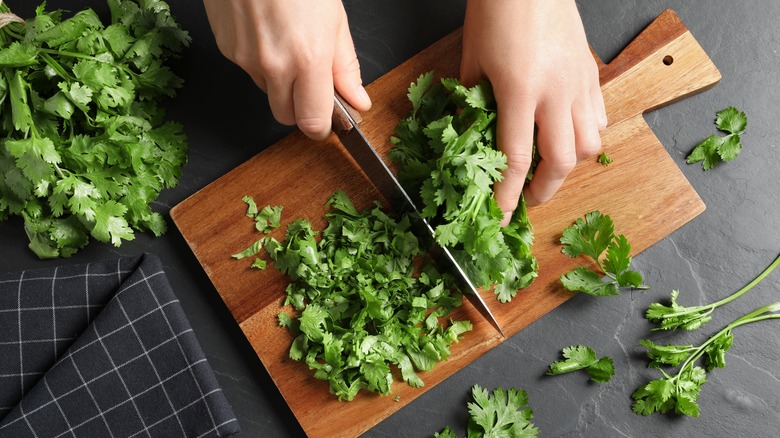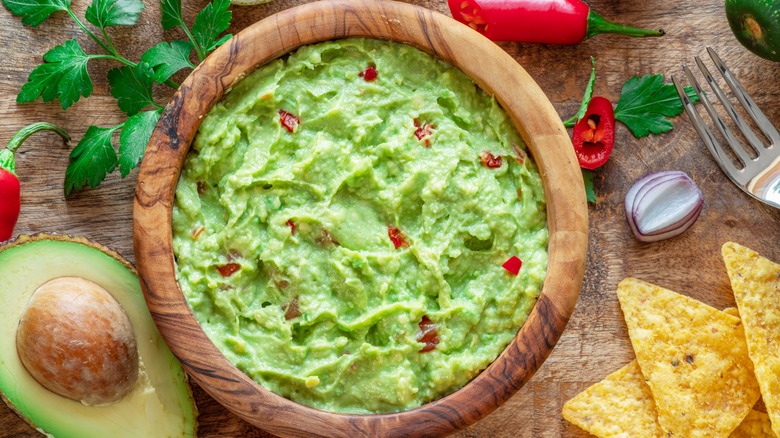15 Tips For Seriously Upgrading Your Nachos
Nowadays, you can find a sheet-pan dinner recipe for pretty much any flavor you're craving. But before all of these existed, there were nachos. The original sheet-pan meal can be found on virtually every bar and diner menu across the country, but while they're now a popular Tex-Mex dish, they're a distinctly Mexican creation. Invented in 1940, nachos were born when Ignacio Anaya, nicknamed Nacho, threw together a quick snack of chips, cheese, and jalapeños to sate the hunger of some guests visiting the restaurant he worked at in Piedras Negras, Mexico. The dish was an instant smash and quickly took hold in other restaurants before Texas-based businessman Frank Liberto created ballpark nachos in 1976, making them even more popular and readily available.
Nachos are typically eaten as a side or an appetizer, but with some careful doubling-up of ingredients and a few additions, they can become a hearty lunch or dinner. And the beauty of nachos is that while they have a few classic elements and ingredients, they can also serve as a vehicle for creativity and new flavors. So, if you've ever had the urge to mix up your nachos, we've got the tips you need to make this dish even more special.
1. Change up your cheese
Nachos were traditionally made with Colby cheese, and it's still commonly used thanks to its mild flavor, vibrant color, and ability to melt easily. Colby-Jack, Monterey Jack, and cheddar are also frequently used. But true nacho aficionados know that you don't have to stick to any of these, and choosing a different cheese can open up your snack to a world of different flavors.
As the beauty of nachos lies in being able to pull chips out and bring a long string of gooey cheese with them, choosing a dairy product that melts well is key. If you like your cheese chewy, gouda is a great choice. This Dutch cheese has a milder, sweeter flavor than other cheeses, thanks to its low acid content. Provolone also delivers a chewy texture and a milder taste, although there are plenty of provolone varieties that come in stronger flavors, and older cheeses will deliver a sharper experience. And if you're looking for a cheese that really announces itself, try using Taleggio. Hailing from Italy, Taleggio has a briny flavor and scent, with a note of nuttiness in it, that makes it the star of the show in a bowl of nachos.
2. Layer like a pro
Although nachos seem pretty simple to make, it's shockingly easy to ruin their assembly with poor layering processes. All too often, nachos arrive at the table in a clumped mass, with burnt, uncovered chips on the edge of the plate, and a mound of thick toppings in the center. You can avoid this by getting your technique right, as the key to perfectly coated nachos is all in the layering, which requires an even spread across all of the chips.
The best way to do this is to use a vessel that has a large, flat surface, like a sheet pan or a big casserole dish. Spread out your chips in a single layer, ensuring there aren't any irregularities or gaps. Then, you can either layer your ingredients one by one, ensuring every chip gets covered, or place strategic blobs of each topping across the dish. You'll want to avoid leaving too many chips completely uncovered, as they'll simply char once they hit your oven or broiler. If you're using thick, difficult-to-distribute ingredients like refried beans, one way to ensure that every chip is topped is by spreading a small amount onto each one. Bear in mind, though, that this can be a time-consuming process, so only do it if you have the patience.
3. Skip the chips, and use a vegetable
Nachos may not win many awards when it comes to nutrition, but in some cases, it might surprise you how unhealthy they are, especially in restaurant settings. The Cheesecake Factory's nachos, for example, contain over 2,600 calories, 84 grams of saturated fat, and 173 grams of carbs — and while this is a dish that's meant to be shared, it's still pretty eye-watering.
While homemade nachos will usually be slightly less calorific and full of fat, if you want to lighten things up while getting some extra fiber, vitamins, and minerals, you can opt to use sliced vegetables instead of tortilla chips. Many vegetables can be sliced into flat, sizeable shapes, and each can provide its own flavor. For a sweeter, softer base layer, try using sweet potatoes sliced into rings, microwaved for a few minutes to soften them. If you still want a little crunch, you can layer the sweet potatoes over some healthy chips, and you'll still get all of the vitamin A, fiber, and antioxidants that live in the vegetable.
4. Add some protein with chicken or chili
Nachos can be made with a dizzying array of toppings, but our favorites are those which turn this from a snack into a meal. And those toppings are usually protein-based and serve to keep you fuller for longer due to them taking longer to digest. For a topping that remains in the flavor realm of nachos, you can't go wrong with chili con carne. This dish, which is a Tex-Mex staple that grew in popularity in the 19th century, delivers a kick of spice and heat to nachos, and the beans in the recipe boost the protein content even more, as well as providing valuable fiber.
If you don't have the energy to cook a pot of chili, though, you can simply shred some seasoned chicken and layer it on top of your tortilla chips. Shredded chicken is a great choice for nachos as it can be mixed with any flavored sauce you like to add more flavor or simply left plain if you prefer. You can easily shred chicken using a rotisserie chicken into large pieces, remove the bones or buy some cooked chicken pieces from the store, and place them in your hand mixer with the paddle attachment. The paddle gently pulls the chicken apart until you're left with easily-workable shreds.
5. Make your nachos vegan-friendly with a cashew queso
Plant-based diets and food alternatives are continuing to rise in popularity, and it's estimated that in 2025, the global plant-based food market will be worth almost 78 billion dollars, according to Statista. And with the seemingly never-ending stream of people trying out animal-free diets, you'll likely be catering to a vegan guest one way. When that happens, sub out your regular nacho cheese sauce for a vegan queso dip, which you can pour over your chips. The sauce blends cashews and almond milk with nutritional yeast to give it a cheesy flavor and adds seasonings like cumin, lime juice, and onion.
Cashews work especially well in vegan cheese sauce substitutions as they're softer and creamier than other nuts, and their fat content allows them to give the sauce a bit of bulk. They also have a relatively mild flavor, which allows the sauce to avoid becoming too nutty and, instead, works as a vehicle for all of the flavors you want to add in. Cashews are also a great source of protein, and they have good levels of magnesium and potassium.
6. Save turning your oven on by using an air fryer
If you're cooking nachos for one, it can feel wasteful to heat up the whole oven. But that's where your air fryer comes in. Air fryers allow you to make personal portions of nachos, and as they're cheaper to run than ovens, you'll be saving money while also cooking your snack in a shorter space of time. Air fryers are essentially stovetop ovens, and require very little preheating time thanks to their rapid airflow action, so you'll get your nachos on the table in no time.
An added benefit of using your air fryer to make nachos is that if you use enough cheese, the dish will cook together to make one fairly uniform piece, which you can then decant from your air fryer basket using a spatula directly onto a plate. Just make sure, when making air fryer nachos, that you don't make too thick of a layer of chips, as horizontal space can be somewhat limited.
7. Use different-colored corn chips
When made well, nachos are a colorful visual feast, with pops of green guacamole shooting up between the confetti-like pico de gallo. But if you want to make something really special, use different-colored corn chips. Opting for blue or red corn chips will give your nachos a new lease on life, and they may have some nutritional benefits too. "Studies have shown that corn anthocyanins may have anti-inflammatory benefits and may also help to control body weight," says "21-Day Belly Fix" author and nutritionist Tasneem Bhatia via Women's Health. These anthocyanins are pigments that are present in natural blue corn chips, which give them their dark blue, almost purple color.
Blue corn chips also have a slightly different taste to regular yellow corn chips, with slightly less saltiness and a mellower, sweeter flavor. Additionally, they're higher in protein, potentially making them more filling. Bear in mind when choosing corn chips, though, that some colored varieties are dyed and may not be made from blue or red corn. They may also be slightly misleading from a health perspective, as while these products can be marketed as being more healthy, they may have similar levels of sodium or fat in them.
8. Try out some new pickles
The best nachos marry different flavors and textures, combining salty, crunchy chips with soft, mellow guacamole and cheese. But it all needs to be finished with some sour heat, which is where pickled jalapeños traditionally come in. If you're bored of those, however, or simply want sourness without spice, using different pickles is a great way to make your nachos more interesting.
You can pickle just about any vegetable by soaking it in a brine of salt and vinegar, and further flavors are added through spices, herbs, or aromatic vegetables like garlic. If you still like your pickles to be slightly punchy, try pickling some sliced radishes. Radishes contain the same compound that gives mustard and horseradish their kick and can provide a different type of heat for your nachos while simultaneously delivering that vinegary tang. Pickled onions can give your nachos a sharp finish and can take the place of chopped green onions scattered over the dish at the end. And if you want to really jazz up your nachos, try using sauerkraut or kimchi. While they will deliver a different, funkier flavor, they're still an exciting way to make a totally different dish.
9. Reheat nachos properly to enjoy them the next day
One of the main issues surrounding nachos is that they can lose their appeal quite quickly. When nachos cool, they can either coagulate or become soggy, and this can make them both unappetizing and challenging to reheat. Placing them in the microwave will only soften the dish up further, as the steam released from the nachos can't escape and gets trapped in the food.
This can be avoided, though, as the trick to reheating leftover nachos is to place them in the oven. Pop them back on a sheet pan, removing any ingredients that might be prone to get soggy or wilt, like lettuce or jalapeños, and place them in a preheated oven for five minutes or so. Be careful not to heat any longer than that, as the chips may start to burn and become brittle. Using parchment paper on your sheet pan will stop the nachos from sticking and save you from having a messy clean-up operation. If you have an air fryer, this can also be used to reheat nachos, but bear in mind that this will likely only work for small portions unless you have a model with a particularly big basket.
10. Make your own refried beans
Refried beans may not appear in every nachos recipe, but when they do, you're in for a treat. These beans are made by cooking them alongside seasonings and then mashing them until they form a creamy, chunky paste. They're a great way to add protein and fiber to a nacho dish and are a particularly good addition for vegetarians and vegans who want their nachos to be more filling.
While you can buy refried beans relatively cheaply, they're super-easy to make at home, and by doing so, you can control what goes in them. Contrary to popular belief, refried beans aren't fried twice, with their Spanish name, frijoles refritos, meaning very fried. As such, they're a pretty healthy dish that can be made even healthier in your own kitchen. If your refried beans become a little thick on the stove, thin them with some added water, stock, or milk. Once you've made refried beans, you can add them to nachos in the same way you would with guacamole or chili, in dollops on top of the chips.
11. Treat your tomatoes well for your pico de gallo
Pico de gallo, which translates to the beak of the rooster, is the perfect way to add some freshness to your nachos. This simple salsa is usually made from a combination of tomatoes, onions, jalapeños, cilantro, and lime juice, with the vegetables chopped up into fine cubes. It's best added to nachos at the very end so that it doesn't lose any of its intense freshness in the oven — and by keeping it in the fridge, the coldness of the salsa can provide an interesting contrast to the heat of the dish.
While it's easy to find pico de gallo in the supermarket, it's way more satisfying to make your own, but it does have a tendency to become watery. But to avoid watery pico de gallo, you must prep your tomatoes properly. Sprinkle a little salt onto your chopped tomatoes, and then leave them for 15 minutes or so. The salt will draw some of the water out of your tomatoes, which will prevent them from doing so when you add the rest of the ingredients and seasonings. Once they've had a chance to release their liquid, drain them off. If you wish, you can also rinse them slightly to remove any excess salt, although we'd recommend simply adding less salt to your finished pico de gallo.
12. Don't forget to season
With everything that's going on in nachos, it can be easy to forget to season them. And, indeed, some nachos won't need any seasoning at all, with the cheese, meat, and other toppings supplying enough flavor to avoid having to make any additions. But in other situations, seasoning is essential for nachos, especially in simpler recipes that only rely on a few ingredients. Seasoning is a quick way to boost flavor without having to spend loads of cash or spend ages making an entirely new topping from scratch.
And remember, seasoning doesn't just mean salt. A quick scrunch of black pepper or a dusting of chili flakes can work wonders on nachos, providing heat and spice without adding sodium. You can also make your own nacho seasoning mix by combining cumin, paprika, chili, and garlic powder, with a pinch or two of salt to boost flavor. Then, dust this over your nachos or between layers of toppings, or use it to season ground beef or shredded chicken. And crucially, seasonings don't always have to be dry: A squirt or two of hot sauce can create additional flavor and stop your nachos from feeling parched.
13. Jazz up your sour cream
Sour cream is an essential component of nachos. The relatively neutral flavor of sour cream works as a counterbalancing force to the bolder elements of the dish and can help to temper any overly spiced meats or fierce jalapeños. The softness of sour cream also works excellently against the crunchiness of the chips.
But sour cream can sometimes feel a bit boring, and if you're using a lot of it, it can overpower the nachos. That's why jazzing it up can add even more flavor to your meal. Perhaps the simplest way is to add a squeeze of fresh lime juice and some chopped cilantro. The lime juice will reinforce the sour elements of the cream, making it taste lighter and more sprightly, while the cilantro adds a herbal note. Grating in a little lime zest will make it taste even more citrusy. Or, if heat is what you're craving, stir in a squirt of hot sauce. Tabasco works well here, with the smokiness of the sauce giving an entirely new layer to nachos, but sriracha is also effective and can give not just heat but a note of garlic and sweetness.
14. Hit them with herbs
For some reason, we tend not to finish off nachos with herbs — most people don't think of them as a dish with greenery going on, and if it does, it's usually from guacamole. But a sprinkle of chopped herbs can be worth its weight in gold. Not only do herbs add fresh, grassy notes to nachos, cutting through the density of the dish, but they also make the snack look much better, which isn't to be underestimated. When food looks more attractive, we perceive it to be tastier and are more positively receptive to it, and fundamentally enjoy our dining experience more.
If you're using traditional herbs, it has to be cilantro. Cilantro has a long history of use in Mexican cuisine, having been introduced to the country in the 16th century. But aside from being the traditional choice for Mexican dishes, cilantro also has a slight spiciness to it that complements other flavors in nachos and a boldness that allows it to stand up against the strong flavors of heavily-seasoned meat, sharp cheese, and hot jalapeños. It's also high in vitamins C, K, and A, giving your nachos a little boost of nutrition. Just ensure that you're adding cilantro at the very last minute and not before you put the nachos in the oven — you don't want it to burn.
15. Sneak some additions into your store-bought guacamole
While making guacamole is relatively easy, sometimes you just don't have the time or energy. And when that happens, store-bought is the next best thing. But premade guacamole that comes in a tub can often taste curiously flat, and you don't want that to distract from your nachos.
Luckily, though, you can easily make your guacamole more interesting with some quick additions. Adding a little extra chopped red onion or fresh tomatoes will give the guacamole a bold flavor without needing to put in elements, like salt or sugar, that might alter the nutritional value of the dish. The same is true with chopped herbs, which are a quick way to make your guacamole taste fresher. A spritz of lime juice can also revive flat guacamole, and the citric acid and vitamin C in it may keep it looking green for longer.
Just make sure you're choosing carefully when buying store-bought guacamole. Brands can often add preservatives, sugars, or sodium sources to their products, counteracting any of the nutritional benefits that you might get from the avocado and vegetables in it. Look carefully at the label of your product, and try to pick one with the fewest added ingredients.
